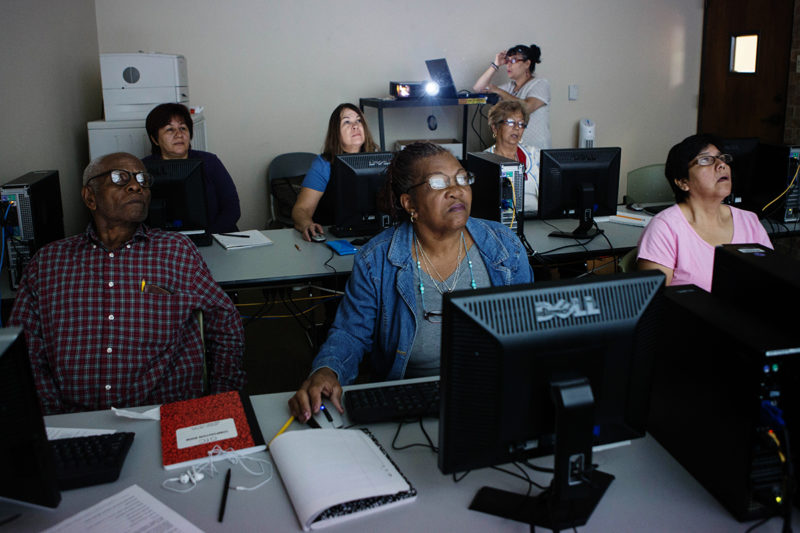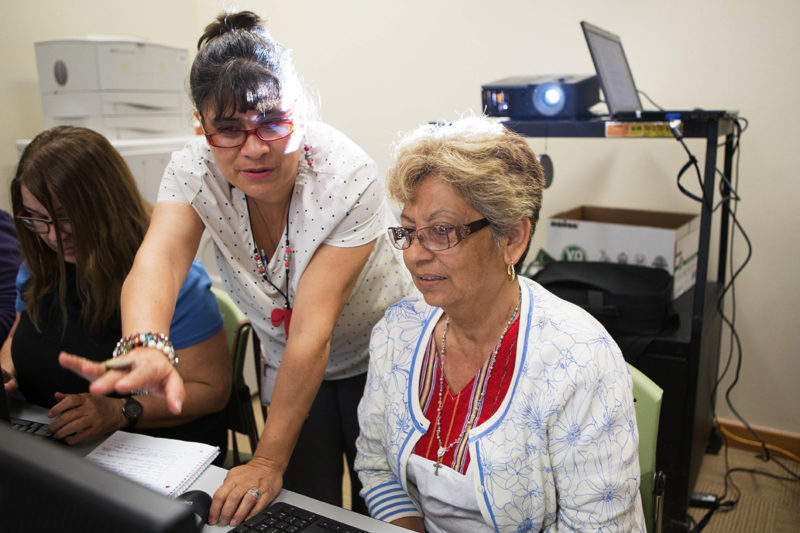Austin Expands Efforts to Serve Non-English Speakers
By Omar Rodriguez Ortiz
Photography By Brianna Walker
Reporting Texas

The Little Walnut Creek Branch Library in North Austin offers Spanish computer classes, among other bilingual services. Brianna Vargas/Reporting Texas
Hai Pham, a native of Vietnam, came to Austin seven years ago. The father of two works at a nail salon.
He sometimes has trouble speaking and understanding English, and sometimes relies on friends to serve as interpreters.
He’s among more than 100,000 Austin residents – 14 percent of the population — who “speak English less than very well,” according to the Census Bureau’s 2015 American Community Survey. Nearly 270,000 people speak a language other than English at home, with Spanish, Chinese and Vietnamese the top three.
Now the city is launching an effort to assure that its websites and services are accessible to those residents.
“That’s good, because a lot of people don’t speak English,” Pham said. In his community, most speak Vietnamese.
The effort will include translating more essential documents into Spanish, Arabic and several Asian languages. About 150 documents have been translated so far, including parking information and health forms related to immunization, city spokesperson Gina McKinley said. The City Council has allocated $250,000 to translate more documents.
Until now, such efforts were patchwork, with some departments doing more than others and some having no plans at all. In November, the council directed the city manager to coordinate efforts across more than 40 departments.
“At the core, it’s that we don’t want people to experience a delay or a denial of city services,” said Vivian Newdick, who was hired in February as language access coordinator in the city’s Communications and Public Information Office. Since she started in that job, she’s been working with other departments to coordinate plans.
A 2016 city audit found that 85 percent of city departments didn’t collect data on the residents they served to understand their language needs, and 75 percent had no language assistance coordinator or plan. Some had created plans but not implemented them.
McKinley, a marketing consultant in the public information office, pointed to the Austin Public Library as one department that has been working for several years to reach out to citizens with limited English skills.

A teacher assists Spanish-speaking student Fela Villegas during one of the weekly bilingual computer classes at the Little Walnut Creek Branch Library. Brianna Walker/Reporting Texas
Several branches hold bilingual story sessions for children and conversational English sessions for adults who are learning the language. The Little Walnut Creek Library on Rundberg Lane provides computer-training classes in English and Spanish. The Ruiz branch on Grove Boulevard has citizenship classes in Spanish.
In 2008, the library started translating its website into Spanish, using its own bilingual employees.
Meanwhile, the city relies on a computerized translation system to translate its main website into Spanish. Someone clicking on the “translate” option would first see a warning that, because it’s a machine translation, it might not be accurate. Austin Energy and Austin Water also use a computerized system.
Improving the translation features of city websites will come sometime next year as part of an overall website redesign, McKinley said.
Austin also may adopt Houston’s “I Speak” cards, which are given to people with limited English. The cards explain how to tell city employees, such as 311 and 911 operators, that the user doesn’t speak English.
For example, the card for Portuguese speakers instructs them to say “Ai spique Portugize,” using phonetics to pronounce “I speak Portuguese.” The city worker then contacts a company that provides interpretation services by phone, day and night.
The city is training employees in departments such as police and library on the I Speak program.
The city also will step up efforts to measure whether its language access efforts are effective.
For example, Austin’s Municipal Court has spent almost $2 million on interpretation services since 2014. Without an effectiveness measurement, there is no way to assure that the services are appropriate for residents with limited English skills
Changes like this “will allow community members who are limited English proficient to have the language-appropriate support that they need so that they can have better access to essential services,” said Raúl Álvarez, executive director of the Community Action Network, which includes 25 government and nonprofit agencies in Central Texas.
Since 2016, CAN has been the facilitator of a working group on language access programs.
“The purpose of the group is to identify strategies and actions that will allow CAN partners and other service providers to better address community language needs,” he said.
In a changing city, there will be a continuing need for language access programs. McKinley said.
“There will always be changing demographics, needs and ways of communicating,” she said.